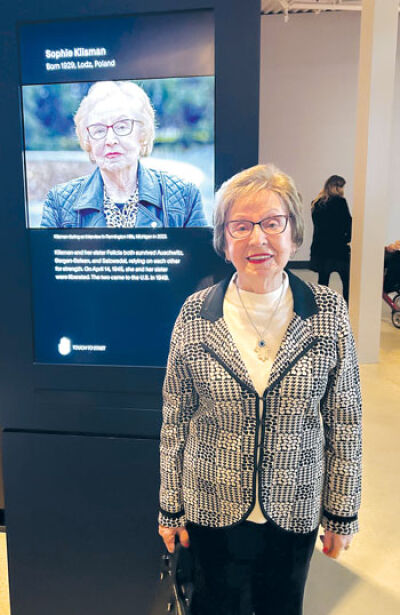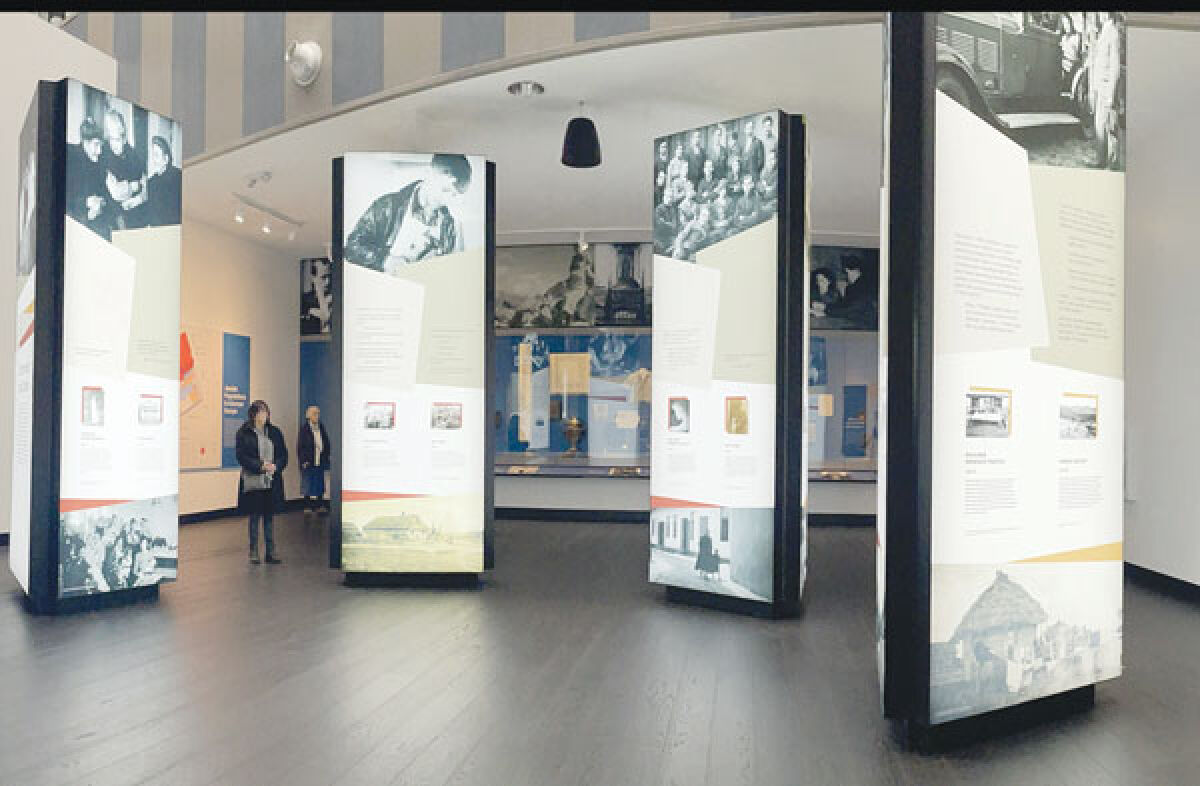
Holocaust survivor Sophie Tajch Klisman was among the visitors at a grand re-opening event that was held at the Zekelman Holocaust Center Jan. 28. Tajch Klisman was featured as part of the new exhibit.
Photo provided by Lori Ellis
FARMINGTON HILLS — The Zekelman Holocaust Center has taken a major step toward ensuring that the voices of local Holocaust survivors will continue to be heard with a recently completed renovation project.
Zekelman, which is the only Holocaust center in Michigan, had a grand re-opening of its core exhibit Jan. 28.
The center has provided Holocaust education at its current location in Farmington Hills since 2004.
Renovation began at the facility last May, with the center undergoing a comprehensive $31 million “transformation,” according to a press release.
“The entire exhibit is fully redesigned from the ground up,” said Mark Mulder, the director of curatorial affairs at the Zekelman Holocaust Center. “In terms of what’s new that you’ll see, other than everything, is the concentrated focus on Michigan survivor stories especially, but not exclusively, and a more integrated use of media and images.”
The new exhibit was part of a collaboration with the Ralph Appelbaum Associates design firm.
According to Mulder, the previous exhibit primarily relied on didactics, which is primarily intended to be an instructive approach.
The new exhibit uses archival footage, images, artifacts and interactive videos featuring survivor testimony in order to let those who experienced the Holocaust be the central focus of the exhibit.
Mulder explained the primary difference between the new exhibit and the previous one that relied more heavily on didactics.
“Instead, we’re giving the same information by telling people’s stories,” he said. “So, rather than, ‘This happened,’ it was, ‘This is what it was like when that happened to me.’”
Local resident Sophie Tajch Klisman is a Holocaust survivor, and her testimony is part of the new exhibit.
According to Tajch Klisman’s daughter, West Bloomfield resident Lori Ellis, her mom was interviewed on the grounds of the Zekelman Holocaust Center last year.
“Since they renovated, their focus is more on local survivors,” Ellis said. “When you enter, there’s this huge wall with my mom’s quote of what her life was like prior to the war. So when people walk into the exhibit, they want (them) to get a feel for what the whole person was like, not just their experience in the camps and during World War II.”
By touching the button of a kiosk, visitors can also hear part of Tajch Klisman’s story.
“You can see and hear her talking about her liberation, and part of it flashes to one of her liberators, Doug Harvey. He was part of the U.S. 84th Infantry who came to liberate the survivors in (a) concentration camp in Germany,” Ellis said. “They were together last year filming this by the Anne Frank tree outside, and they were pleased with how the interview went, so they wanted to, I guess, memorialize it, and my mother was thrilled that it will be there forever, and her story will live on.”
The fact that Harvey and her mom were filmed together makes the exhibit all the more impactful for Ellis.
“It was like a piece of history watching the two of (them) together, a survivor and a U.S. Army liberator,” Ellis said. “So it’s there forever now at the museum.”
Ellis shared details about how her mom felt seeing her words in quotes and seeing a kiosk that provides information about her liberation.
“She was grateful that the museum is showing more coverage of local survivor testimonies so their legacy can live on forever,” Ellis stated via email. “She felt with her exhibits it did not convey the horror, pain and suffering that she and her family went through. She stated she trusts that the museum is still keeping that memory alive. … Her kiosk shared a happy time when she was liberated or given a second chance of life.”
According to the release, there was an urgency on the part of the Zekelman Holocaust Center to ensure that the stories and experiences of Holocaust survivors remain accessible to future generations, with the center recognizing the importance of adapting.
“The greatest differentiating factor between the original and the new exhibit is the centering of the voices of those who experienced the Holocaust,” Zekelman CEO Eli Mayerfeld stated in the release. “Throughout the exhibit, visitors will hear the personal stories of those who survived the Holocaust and rebuilt their lives in Michigan after the war. By localizing the history from the perspective of those who lived it, rather than those who perpetrated it, we are showing that the Holocaust did not happen so long ago or so far away.”
According to Mulder, the exhibit is telling stories as much as possible. One of the ways that has been accomplished is via an area of the exhibit titled “People and Possessions,” which features artifacts that represent losses people had as a result of the Nazis.
One such example includes wedding rings that were found by U.S. soldiers.
“There are a few artifacts that I know have been contextualized and utilized in such a way that everybody is catching the story and picking up on them,” Mulder said. “There was a room in the old exhibit that featured a lot of graphic Holocaust liberation imagery that now we use to talk about the possessions and lives that were taken from people within the camps, in that space, in particular. It’s really been moving for our visitors. … This is a space where we partially help people to see there are stories we can’t tell because we’ll never know the stories behind some of these artifacts because of what happened to the previous owners and the people who were associated with them before.”
According to Mulder, the exhibit has 60 Holocaust survivors from Michigan featured in different ways, including quotes printed on the wall, videos and artifacts.
Although there are newer recordings, such as Tajch Klisman’s, Mulder said most of the recordings and testimonies were given to the center throughout the history of the institution.
The last day construction workers were in the building was Dec. 3, with the funds for the project coming from donations, according to Mulder.
He studied museology at the University of Washington and said that a decade’s worth of research has brought things to this point.
“A project like this might only come around once in my career,” Mulder said. “To say that it is extraordinarily satisfying is (an) understatement. … I’ve been researching this topic since undergrad, and my graduate thesis was on Holocaust representation in museums. … It is such a moving experience.”
Stories such as that of Tajch Klisman’s are at the heart of the new exhibit.
“Each time I see it, it’s just so meaningful,” Ellis said. “I get emotional — just so proud of my mother, of how she has had the ability to be so resilient and share her story with the world.”
 Publication select ▼
Publication select ▼























